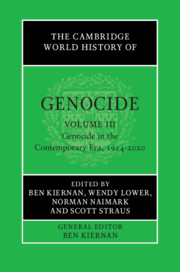Book contents
- The Cambridge World History of Genocide
- The Cambridge World History of Genocide
- The Cambridge World History of Genocide
- Copyright page
- Contents
- Figures
- Tables
- Maps
- Contributors to Volume III
- Introduction to Volume III
- Part I Racism, Total War, Imperial Collapse and Revolution
- Part II World War Two
- Part III The Nation-State System during the Cold War
- 17 Genocide in Latin America, 1950–2000
- 18 China under Mao, 1949–1976
- 19 Half a Century of Genocide and Extermination
- 20 Secession and Genocide in the Republic of Biafra, 1966–1970
- 21 Bangladesh, 1971
- 22 The Genocides in Cambodia, 1975–1979
- 23 The Guatemalan Genocide
- 24 Mass Violence and the Kurds
- 25 Vulnerable Peoples in the Contemporary Era
- Part IV Globalisation and Genocide since the Cold War
- Index
22 - The Genocides in Cambodia, 1975–1979
from Part III - The Nation-State System during the Cold War
Published online by Cambridge University Press: 23 June 2023
- The Cambridge World History of Genocide
- The Cambridge World History of Genocide
- The Cambridge World History of Genocide
- Copyright page
- Contents
- Figures
- Tables
- Maps
- Contributors to Volume III
- Introduction to Volume III
- Part I Racism, Total War, Imperial Collapse and Revolution
- Part II World War Two
- Part III The Nation-State System during the Cold War
- 17 Genocide in Latin America, 1950–2000
- 18 China under Mao, 1949–1976
- 19 Half a Century of Genocide and Extermination
- 20 Secession and Genocide in the Republic of Biafra, 1966–1970
- 21 Bangladesh, 1971
- 22 The Genocides in Cambodia, 1975–1979
- 23 The Guatemalan Genocide
- 24 Mass Violence and the Kurds
- 25 Vulnerable Peoples in the Contemporary Era
- Part IV Globalisation and Genocide since the Cold War
- Index
Summary
In 2018, the UN-sponsored Extraordinary Chambers in the Courts of Cambodia (ECCC) found that Pol Pot’s Khmer Rouge regime had perpetrated two genocides while in power from 1975 to 1979. The Trial Chamber of the ECCC’s hybrid international-national court in Phnom Penh convicted the two surviving top leaders of that regime. Both Nuon Chea, Pol Pot’s number 2, and Khieu Samphan, the regime’s head of state from 1976 to 1979, were found guilty of the genocide of Cambodia’s ethnic Vietnamese minority. Samphan thus became the first head of state to be convicted of genocide in an international court. The Trial Chamber also found Nuon Chea guilty of the genocide of the country’s ethnic Cham Muslim minority.1 The ECCC had previously, in 2014, convicted both men of crimes against humanity for the persecution and mass murder of members of their country’s Khmer majority population, and they were already serving life sentences in Phnom Penh.2
- Type
- Chapter
- Information
- The Cambridge World History of Genocide , pp. 518 - 549Publisher: Cambridge University PressPrint publication year: 2023



